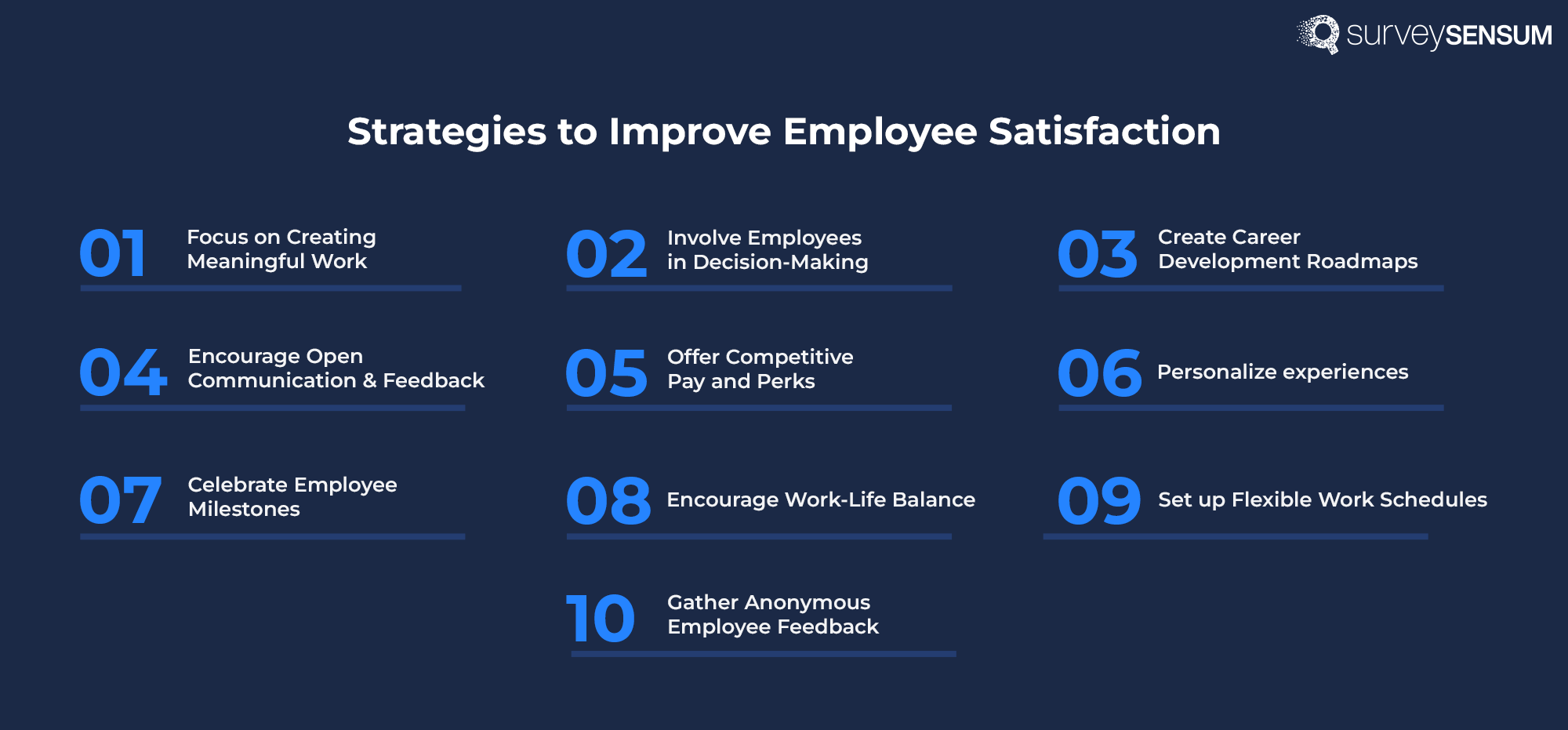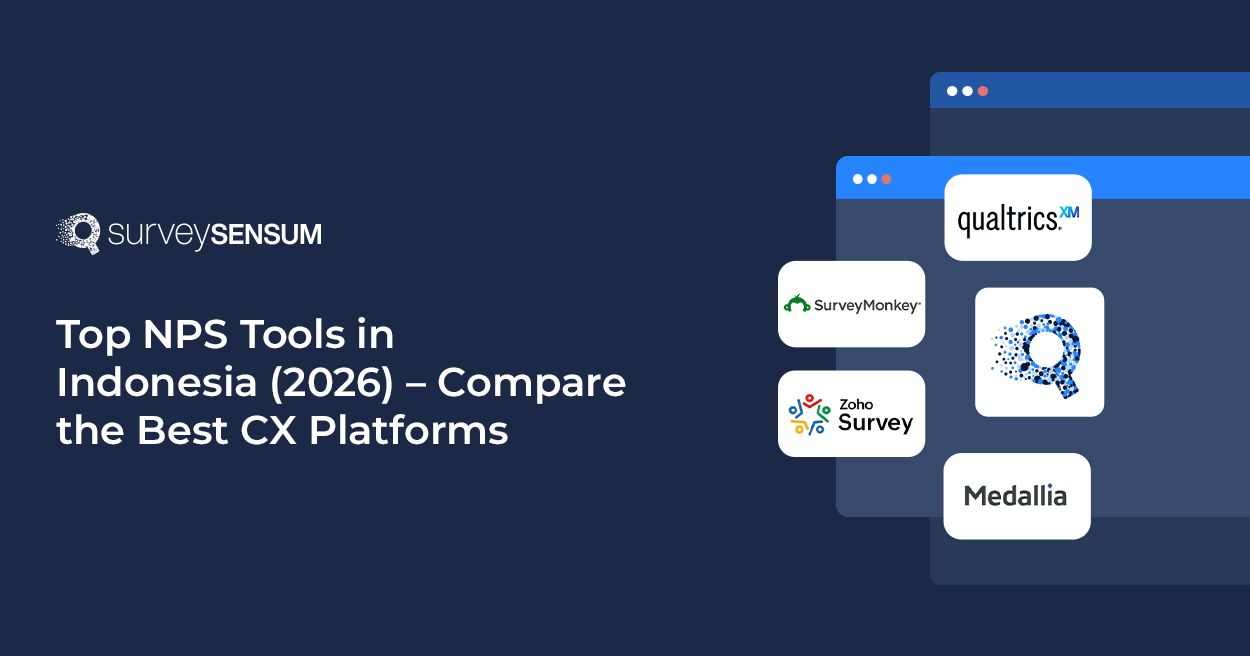

Satisfied employees = Satisfied customers.
Don’t believe me?
Read this – When there is employee satisfaction, employee productivity increases by 40% which in turn increases customer satisfaction by 18%.
That’s quite a substantial number, right? Well, after working for multiple organizations I can tell you that an elevated employee experience is absolutely integral to the success of your business!
It is an aspect that often goes ignored by many organizations and even those that focus on it, fail to do it the right way.
And a powerful employee feedback tool can help you with that!
So, to prevent you from missing this great opportunity, this article will talk about how you can improve employee satisfaction within your organization.
But first, let us know more about the impact of employee satisfaction.
Why is Employee Satisfaction Important?
Here are the top 5 reasons why you need to improve your employee satisfaction:
1. High Productivity:
Companies with satisfied employees outperform competitors by 20%. This shows how satisfied employees are more motivated and engaged, leading to higher productivity levels. When employees feel valued and appreciated, they are likely to put in more effort and work efficiently.
2. Inflated Retention:
Employees who are satisfied with their work and workplace are 59% less likely to look for a job with a different organization. So yes, high employee satisfaction reduces turnover rates. This saves on recruitment and training costs associated with replacing staff.
3. Improved Customer Satisfaction:
Companies with highly engaged employees outperform competitors by 26% in terms of customer satisfaction ratings. This leads to the fact that your satisfied employees are more likely to provide your customers with excellent service. They are motivated to go the extra mile to ensure customer satisfaction, leading to increased customer loyalty and positive word-of-mouth recommendations.
4. Positive Employer Branding:
Companies with satisfied employees are 1.5 times more likely to attract top talent compared to those with lower employee satisfaction levels. This figure just proves the fact that a reputation for high employee satisfaction will attract top talent to your company. This will lead to a stronger employer brand and a competitive advantage in recruiting. Partnering with executive recruitment agencies can further amplify that brand perception in the market and help you secure leaders who fit your culture.
5. Business growth:
Disengaged employees cost organizations between $450 billion to $550 billion annually. Sounds absurd, right? Businesses can, therefore, save a lot of money and effort if their employees are satisfied as it has a profound impact on business growth across various key areas.
Now you know why employee satisfaction is important for a business, as it significantly influences their success and growth. Now, let’s explore the most essential thing- how to achieve this satisfaction.
How to Improve Employee Satisfaction: 9 Strategies
Here are the 9 strategies to improve employee satisfaction:

1. Focus on Creating Meaningful Work
Encourage employees to contribute to something bigger than themselves. When employees understand the purpose behind their work and how it aligns with the organization’s goals and values, they feel a sense of fulfillment and motivation.
To achieve this:
- Clearly communicate the organization’s mission, vision, and values to employees.
- Provide opportunities for employees to see the impact of their work on the organization, customers, or society.
- Foster a culture that recognizes and celebrates employees’ contributions and achievements.
- Offer job enrichment opportunities that allow employees to take on new challenges, develop skills, and grow professionally.
- Encourage open dialogue and feedback to ensure employees feel valued and engaged in their work.
2. Involve Employees in Decision-Making
Involve employees in decisions that affect their daily routines or tasks. This approach demonstrates trust in employees’ opinions and fosters a sense of ownership and commitment.
To achieve this:
- Gather feedback from employees on relevant policies, procedures, and initiatives.
- Establish cross-functional teams to collaborate on decision-making processes.
- Provide training and resources to empower employees to participate effectively in decision-making.
- Communicate the rationale behind decisions and how employee input influenced the outcome.
- Recognize and reward employees for their contributions to decision-making processes.
3. Create Career Development Roadmaps
A study by the Robert Walters Group found that 69% of millennials said career progression keeps them engaged at work.
Provide employees with clear pathways for career advancement and growth within the organization. When employees understand how they can progress from their current roles to more senior positions, they feel motivated and engaged.
To achieve this:
- Identify key skills and competencies required for advancement in various roles.
- Offer training, mentorship, and development programs to help employees acquire necessary skills and write their resume.
- Provide opportunities for job rotation, stretch assignments, and promotions based on merit and performance.
- Regularly review and update career development plans to align with employees’ aspirations.
4. Encourage Open Communication and Feedback
Did you know that 70% of employees believe that regular feedback and criticism from managers enhances their job performance?
Foster a culture of open communication and continuous feedback to support employee growth and development. Employees value regular feedback on their performance and opportunities for improvement.
To achieve this:
- Provide timely and constructive feedback to employees on their work and contributions.
- Encourage two-way communication between managers and employees, sending employee feedback surveys, and allowing for dialogue, questions, and suggestions.
- Implement regular check-ins or one-on-one meetings to discuss progress, goals, and development opportunities.
- Create a feedback-friendly environment where employees feel comfortable sharing their thoughts, concerns, and ideas. Explore Remote People for more insights on optimizing remote work practices.
Waste No Time In Improving Employee Satisfaction. Launch Your Expertly Crafted Employee Surveys In Under 5 Minutes With Surveysensum!
5. Offer Competitive Pay and Perks
Ensure that compensation and benefits packages are competitive and aligned with industry standards to attract and retain top talent. One smart and accessible strategy for offering competitive salaries without straining your budget is to explore international recruitment. Hiring skilled professionals from abroad allows you to optimize payroll costs while maintaining exceptional employment standards. Recognize the value of employees’ contributions by offering fair and competitive pay and perks, invest in talent development initiatives to recognize and nurture employees’ contributions, fostering long-term growth and engagement.
- Salary increases, bonuses, and performance-based equity awards based on performance and market benchmarks.
- Comprehensive benefits packages, including health insurance, retirement plans, and paid time off.
- Additional perks and amenities, such as wellness programs, flexible spending accounts, and employee discounts.
6. Personalize experiences
According to the Zendesk EX trends report, 87% of EX professionals stated that personalization increases employee satisfaction.
Recognize and appreciate the unique talents, preferences, and needs of individual employees by personalizing their work experiences. Make efforts to create a supportive and inclusive environment where employees feel seen, valued, and appreciated.
To achieve this:
- Tailor job roles, assignments, and responsibilities to fit employees’ skills, interests, and career goals.
- Provide opportunities for professional development and growth that align with employees’ aspirations.
- Offer flexibility in work arrangements, schedules, and workspaces to accommodate individual needs and preferences.
7. Celebrate Employee Milestones
Acknowledge and celebrate the achievements, milestones, and contributions of employees to foster a culture of recognition and appreciation. Recognize both individual and team accomplishments to boost morale and motivation.
To achieve this:
- Host recognition events, ceremonies, or awards programs to honor outstanding achievements.
- Publicly acknowledging and praising employees’ contributions through newsletters, emails, or social media.
- Provide personalized tokens of appreciation, such as awards, certificates, or gift cards.
- Encouraging peer-to-peer recognition and expressions of gratitude among team members.
8. Encourage Work-Life Balance
According to a study conducted by the IBM Institute for Business Value, 51% of employees consider work-life balance as the top factor influencing engagement within an organization.
Promote work-life balance to support employees’ overall well-being and enhance job satisfaction. Recognize the importance of allowing employees to manage their personal and professional responsibilities effectively.
To achieve this:
- Offer flexible work arrangements, such as telecommuting, flexible hours, or compressed workweeks.
- Provide resources and support for managing stress, maintaining wellness, and achieving work-life harmony.
- Set clear expectations and boundaries around work hours, workload, and availability.
- Encourage employees to take breaks, vacations, and time off to recharge and rejuvenate.
9. Set up Flexible Work Schedules
A recent McKinsey survey revealed that 87% of employees choose flexible working models when given the opportunity.
Recognize the value of flexibility in work arrangements to accommodate employees’ diverse needs and preferences. Offer flexible work schedules and arrangements that empower employees to balance their professional and personal commitments.
To achieve this:
- Allow employees to adjust their work hours or location based on their individual circumstances and preferences.
- Provide technology and tools to support remote work, collaboration, and productivity.
- Establish clear guidelines and expectations for remote work, including communication protocols and performance metrics. Plus, explore what is remote device management for efficient device monitoring and security from a centralized location.
- Encourage managers and teams to embrace flexibility and adaptability in their work practices and routines.
10. Gather Anonymous Employee Feedback
Research by IBM found that employees who believe their voice is heard are 4.6 times more likely to feel empowered to perform their best work.
Gathering anonymous employee feedback plays a crucial role in enhancing employee satisfaction within an organization. By providing a platform for employees to share their thoughts, opinions, and concerns anonymously, organizations can create a safe space for honest feedback.
To achieve this:
- Leverage an employee feedback tool to offer employees a secure and confidential platform to share their feedback.
- Promote a culture of open communication and assure employees that their feedback will be used constructively.
- Guarantee that feedback remains anonymous throughout the process to build trust and encourage genuine input.
- Regularly analyze the feedback collected to identify common issues and areas for improvement.
- Act on the feedback by addressing identified issues and communicating changes to show that feedback is taken seriously.
Conclusion
By implementing these strategies, organizations can create a supportive, inclusive, and engaging work environment that enhances employee satisfaction, retention, and overall success.
These strategies will help you improve your employee satisfaction which is a strategic imperative for any organization looking to climb the ladder of business success. By investing in employee satisfaction you can yield a multitude of benefits.
And your efforts will come to fruition with the help of a robust employee feedback tool like SurveySensum. With SurveySensum, you can create effective surveys with engaging employee satisfaction questions and analyze the gathered feedback with powerful AI-enabled features like Text Analytics. You get a comprehensive overview of your feedback process with an intuitive dashboard as well as have the chance to effortlessly close the feedback loop.

















